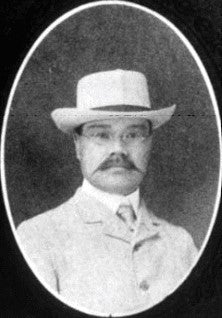The Saibara Family

Seito Saibara (1861-1939), former President of Doshisha University in Kyoto, Japan, and the first Christian member of the Japanese Diet (Parliament), arrived in the United States in 1901 to study theology at the Hartford Theological Seminary and was the first member of the Saibara Family to come to the US. In August of 1903 he was invited to come to Texas by the Houston Chamber of commerce in order to help advise farmers on the cultivation of rice, a then new and emerging crop. Rice as a crop had been successful in Honduras or the Carolinas yielding 18-20 barrels an acre and chamber desired similar success in Texas.
Seito Saibara would accept the invitation and would then ask his wife and oldest son, Kiyoaki Saibara (1884-1972), to bring 300 pounds of shinriki seed from Japan, a superior variety. With the arrival of the wife and son, the Saibara family hence started to establish itself in Texas. Together, father and son, 1,000 acres of rice were planted in Webster. Performing much better than the seed from Honduras or the Carolinas, the Japanese seed yielded 34 barrels per acre. The first crops were primarily distributed as seed in Texas and Louisiana. Marked by success, the Saibara farm continued to expand and the family worked on creating or implementing techniques to more efficiently cultivate Rice. The Saibaras are credited with building the multimillion-dollar Texas rice industry with their improved rice strains and production techniques. As other families arrived to help with the farming, the first Japanese colony in Texas took root.
Following the success of the Saibara farm and financial safety of the family, Kiyoaki felt it was time for him to get married and thus told his father. His father arranged for him to meet Shimoyo Iwasaki, the daughter of a friend in Japan in San Francisco, Calfironia. As the daughter of a samurai, Shimoyo received an expansive education at a Christian school in Japan where whe learned about English and the faith. After meeting there, they began attending consular social events and decided to marry. The ceremony was held in Webster Presbyterian Church on July 10, 1909. Adorned with blossoms, The little white church shone brightly on the prairie. Among the wedding guests were Japanese consular officials, a tribute to the high esteem in which the Japanese government held Seito Saibara.
During World War II, the Japanese Americans were looked down upon and discriminated against as many were forced into internment camps. Yet, Kiyoaki helped the country that would not accept him by using short-wave radio to explain to his countrymen in Japan that the United States was a place where a man was accorded dignity, where a farmer could grow rice and prosper, and that he and many others would be proud to serve the United states in this time of crisis. In his messages he also urged that the Japanese government should extend to its “enemy aliens and prisoners of war the same kind of treatment as is accorded to us." His messages carried a heavy weight as many of the Japanese in the US were eager to join the US in its war effort. [1]
Eight years after the war in 1953 and almost 50 years after his arrival, Kiyoaki Saibara became the first Japanese to become a U.S. citizen in Houston, and probably all of Texas. This was because until 1952, due to the passing of an immigration law in 1906, Japanese were prohibited from acquiring U.S. citizenship. Saibara's outstanding record in Texas was persuasive in making Congress change its mind.
An interesting anecdote of the Saibara family is one of John Glenn, the world-famous U.S. astronaut, and Kiyoaki Saibara. The two would meet before Glenn would go for a trip to Japan. The conversation began with Mr. Saibara startling the famous astronaut when he said, “Colonel Glenn, when you get to Japan, if you should meet the Emperor, would you give him my regards?” John Glenn smiled inwardly, seriously doubting that the Emperor would recognize the name of an obscure rice farmer from Webster, Texas. But when Mr. Glenn did meet the Emperor, he thought there was no harm in trying it, and said, “Your Majesty, do you know a Mr. K. Saibara in Webster, Texas?” The Emperor immediately flashed a big smile and said, “How is my dear friend, Mr. Saibara?”
What John Glenn did not know was that Mr. Saibara had done much to cement American-Japanese relations after the war and was well known by the Emperor. Mr. Saibara was in fact well known across Japan, as many ambassadors from Japan would stop in Webster to get a chance to talk to him and receive counsel on relations between the U.S. and Japan before continuing on to Washington, D.C. Kiyoaki Saibara farmed rice and raised cattle until he retired in 1964 at age 79. He died in 1972.
Kiyoaki's eldest son, Robert, served in the U.S. Army, rising to the rank of Lieutenant Colonel, the highest rank at that time held by a person of Japanese ancestry. Kiyoaki’s second son, Warren, also served in the Army. The youngest son, Harvey, was killed while in training in the Air Force. Robert graduated from Texas A&M University in Electrical Engineering and was a lifelong Aggie supporter. Robert and his wife, Rola, had three daughters, Phyllis, Judy and Marjie, three grandchildren, Mike, Mark, and Holly, and one great-granddaughter, Brittany. As the family grows the legacy of the Saibara Family continues to spread its influence.
An interview with Nancy Saibara, a descendant of Seito Saibara, can be found in HAAA's oral history collection.
References
1. Walls, Thomas K. (1987) The Japanese Texans, San Antonio: University of Texas, Institute of Texan Cultures at San Antonio, 1996.
